Financial Report: Asset Impairment Analysis of Myer Holdings Limited
VerifiedAdded on 2020/02/24
|7
|1543
|55
Report
AI Summary
This report examines asset impairment for Myer Holdings Ltd, focusing on the application of IAS 36 and AASB 136. It analyzes the necessity of impairment testing, the processes involved, and the information required by businesses. The report evaluates Myer's approach to asset impairment, including the use of the discounted cash flow model and the determination of recoverable amounts for goodwill and other assets. It highlights the information Myer needs for impairment testing, considering both internal and external sources. The report also discusses the flexibility available to Myer's management in determining asset impairment, emphasizing the importance of annual reviews and the consideration of cash-generating units (CGUs). The analysis concludes that asset impairment is a key concern for Myer, requiring regular reviews to ensure accurate financial reporting. References to relevant accounting standards and Myer's annual reports support the analysis.
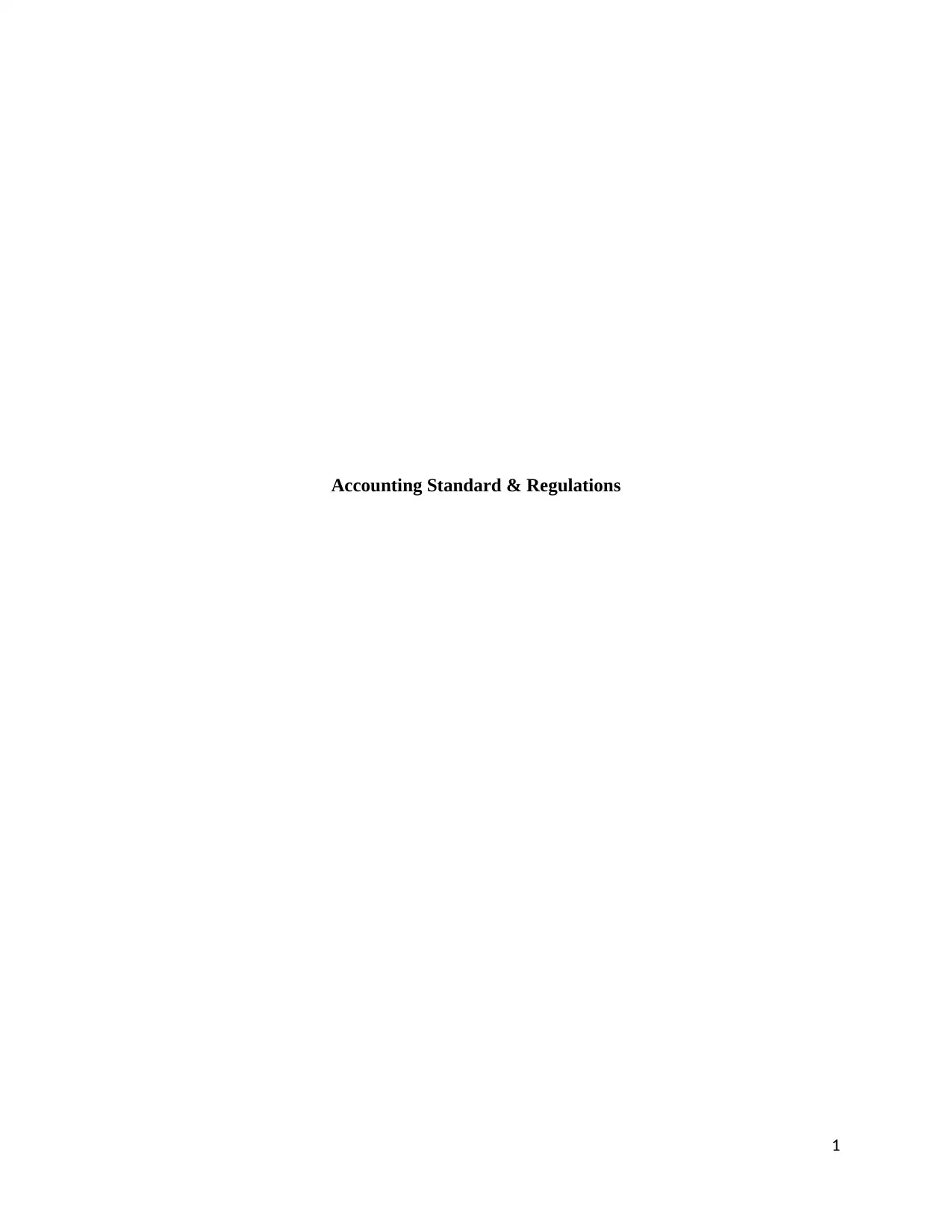
Accounting Standard & Regulations
1
1
Paraphrase This Document
Need a fresh take? Get an instant paraphrase of this document with our AI Paraphraser
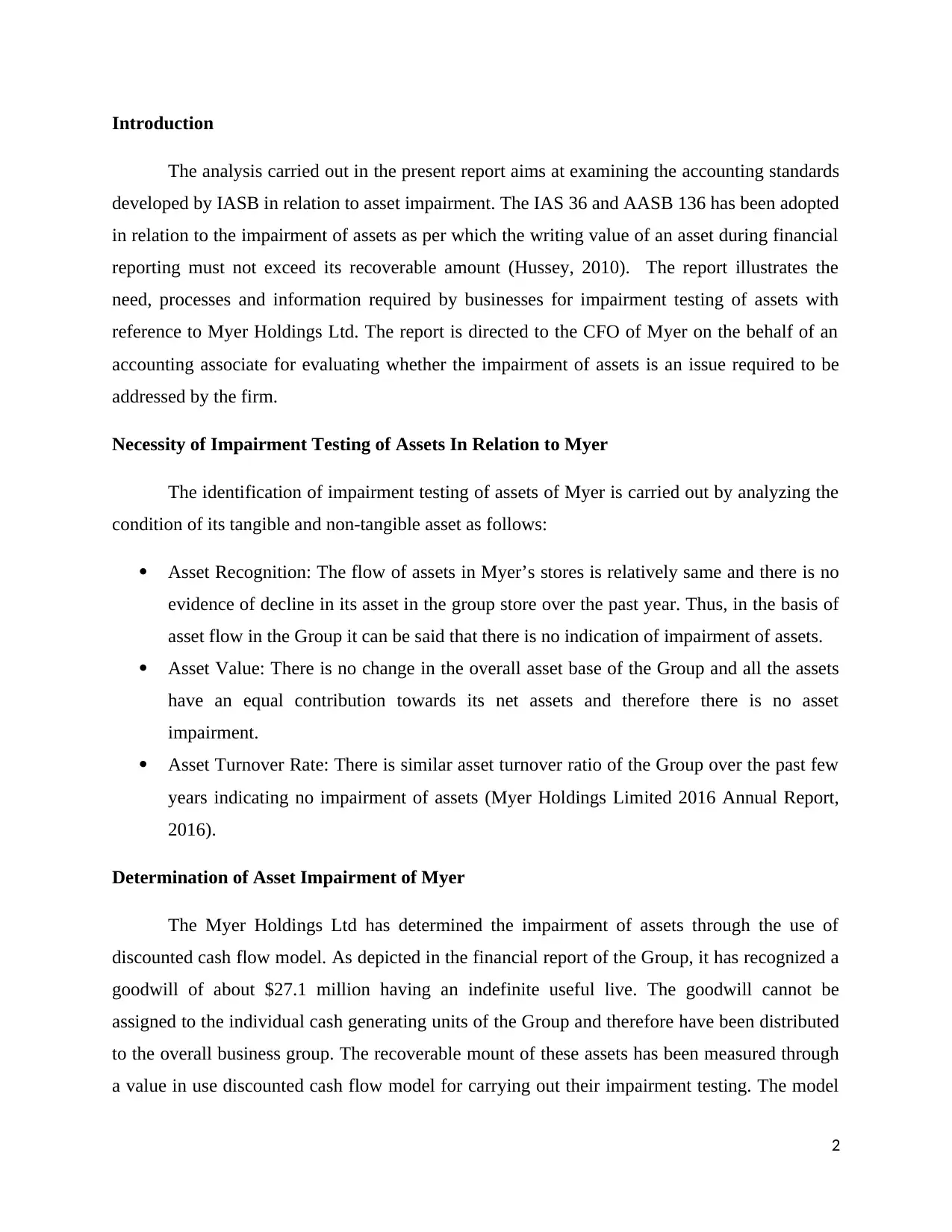
Introduction
The analysis carried out in the present report aims at examining the accounting standards
developed by IASB in relation to asset impairment. The IAS 36 and AASB 136 has been adopted
in relation to the impairment of assets as per which the writing value of an asset during financial
reporting must not exceed its recoverable amount (Hussey, 2010). The report illustrates the
need, processes and information required by businesses for impairment testing of assets with
reference to Myer Holdings Ltd. The report is directed to the CFO of Myer on the behalf of an
accounting associate for evaluating whether the impairment of assets is an issue required to be
addressed by the firm.
Necessity of Impairment Testing of Assets In Relation to Myer
The identification of impairment testing of assets of Myer is carried out by analyzing the
condition of its tangible and non-tangible asset as follows:
Asset Recognition: The flow of assets in Myer’s stores is relatively same and there is no
evidence of decline in its asset in the group store over the past year. Thus, in the basis of
asset flow in the Group it can be said that there is no indication of impairment of assets.
Asset Value: There is no change in the overall asset base of the Group and all the assets
have an equal contribution towards its net assets and therefore there is no asset
impairment.
Asset Turnover Rate: There is similar asset turnover ratio of the Group over the past few
years indicating no impairment of assets (Myer Holdings Limited 2016 Annual Report,
2016).
Determination of Asset Impairment of Myer
The Myer Holdings Ltd has determined the impairment of assets through the use of
discounted cash flow model. As depicted in the financial report of the Group, it has recognized a
goodwill of about $27.1 million having an indefinite useful live. The goodwill cannot be
assigned to the individual cash generating units of the Group and therefore have been distributed
to the overall business group. The recoverable mount of these assets has been measured through
a value in use discounted cash flow model for carrying out their impairment testing. The model
2
The analysis carried out in the present report aims at examining the accounting standards
developed by IASB in relation to asset impairment. The IAS 36 and AASB 136 has been adopted
in relation to the impairment of assets as per which the writing value of an asset during financial
reporting must not exceed its recoverable amount (Hussey, 2010). The report illustrates the
need, processes and information required by businesses for impairment testing of assets with
reference to Myer Holdings Ltd. The report is directed to the CFO of Myer on the behalf of an
accounting associate for evaluating whether the impairment of assets is an issue required to be
addressed by the firm.
Necessity of Impairment Testing of Assets In Relation to Myer
The identification of impairment testing of assets of Myer is carried out by analyzing the
condition of its tangible and non-tangible asset as follows:
Asset Recognition: The flow of assets in Myer’s stores is relatively same and there is no
evidence of decline in its asset in the group store over the past year. Thus, in the basis of
asset flow in the Group it can be said that there is no indication of impairment of assets.
Asset Value: There is no change in the overall asset base of the Group and all the assets
have an equal contribution towards its net assets and therefore there is no asset
impairment.
Asset Turnover Rate: There is similar asset turnover ratio of the Group over the past few
years indicating no impairment of assets (Myer Holdings Limited 2016 Annual Report,
2016).
Determination of Asset Impairment of Myer
The Myer Holdings Ltd has determined the impairment of assets through the use of
discounted cash flow model. As depicted in the financial report of the Group, it has recognized a
goodwill of about $27.1 million having an indefinite useful live. The goodwill cannot be
assigned to the individual cash generating units of the Group and therefore have been distributed
to the overall business group. The recoverable mount of these assets has been measured through
a value in use discounted cash flow model for carrying out their impairment testing. The model
2
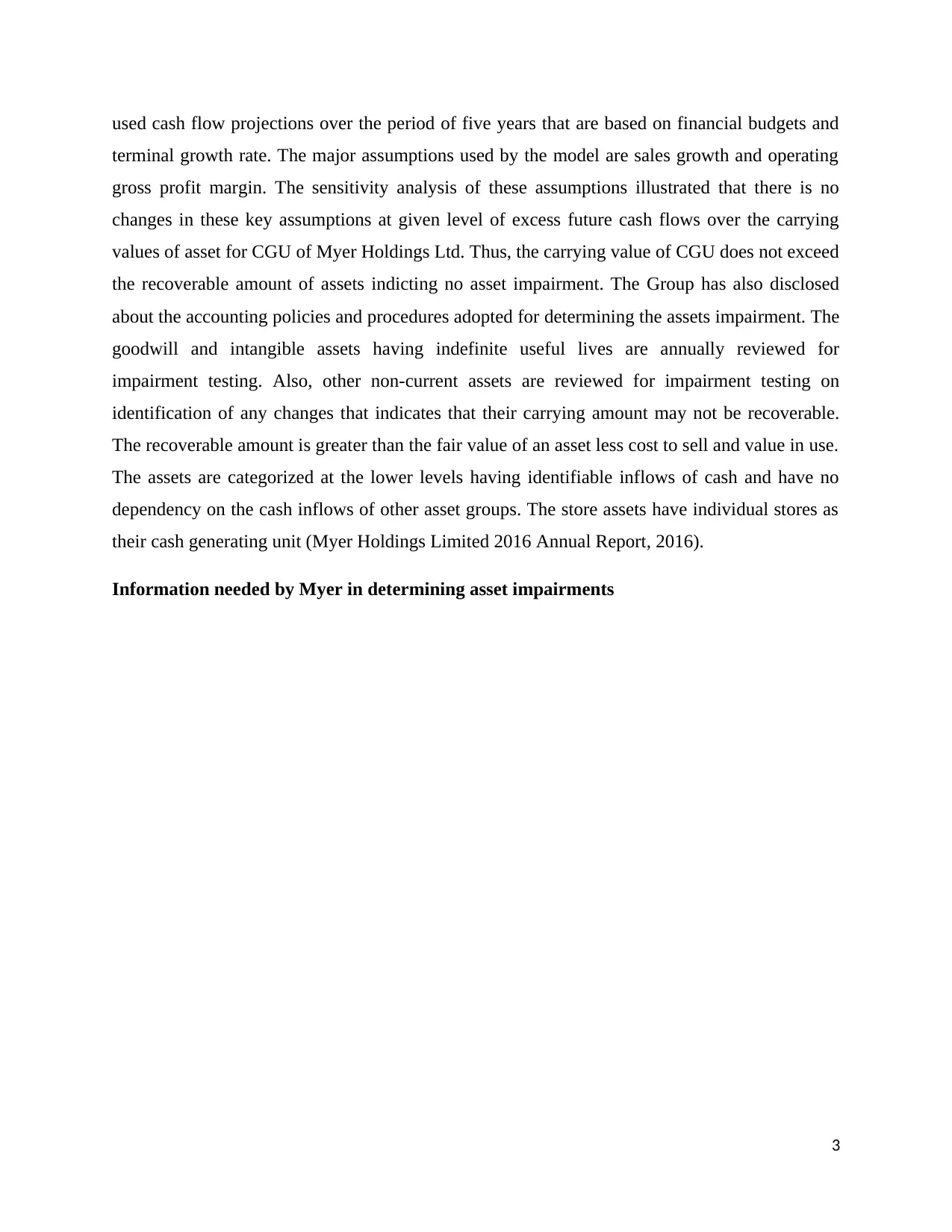
used cash flow projections over the period of five years that are based on financial budgets and
terminal growth rate. The major assumptions used by the model are sales growth and operating
gross profit margin. The sensitivity analysis of these assumptions illustrated that there is no
changes in these key assumptions at given level of excess future cash flows over the carrying
values of asset for CGU of Myer Holdings Ltd. Thus, the carrying value of CGU does not exceed
the recoverable amount of assets indicting no asset impairment. The Group has also disclosed
about the accounting policies and procedures adopted for determining the assets impairment. The
goodwill and intangible assets having indefinite useful lives are annually reviewed for
impairment testing. Also, other non-current assets are reviewed for impairment testing on
identification of any changes that indicates that their carrying amount may not be recoverable.
The recoverable amount is greater than the fair value of an asset less cost to sell and value in use.
The assets are categorized at the lower levels having identifiable inflows of cash and have no
dependency on the cash inflows of other asset groups. The store assets have individual stores as
their cash generating unit (Myer Holdings Limited 2016 Annual Report, 2016).
Information needed by Myer in determining asset impairments
3
terminal growth rate. The major assumptions used by the model are sales growth and operating
gross profit margin. The sensitivity analysis of these assumptions illustrated that there is no
changes in these key assumptions at given level of excess future cash flows over the carrying
values of asset for CGU of Myer Holdings Ltd. Thus, the carrying value of CGU does not exceed
the recoverable amount of assets indicting no asset impairment. The Group has also disclosed
about the accounting policies and procedures adopted for determining the assets impairment. The
goodwill and intangible assets having indefinite useful lives are annually reviewed for
impairment testing. Also, other non-current assets are reviewed for impairment testing on
identification of any changes that indicates that their carrying amount may not be recoverable.
The recoverable amount is greater than the fair value of an asset less cost to sell and value in use.
The assets are categorized at the lower levels having identifiable inflows of cash and have no
dependency on the cash inflows of other asset groups. The store assets have individual stores as
their cash generating unit (Myer Holdings Limited 2016 Annual Report, 2016).
Information needed by Myer in determining asset impairments
3
⊘ This is a preview!⊘
Do you want full access?
Subscribe today to unlock all pages.

Trusted by 1+ million students worldwide
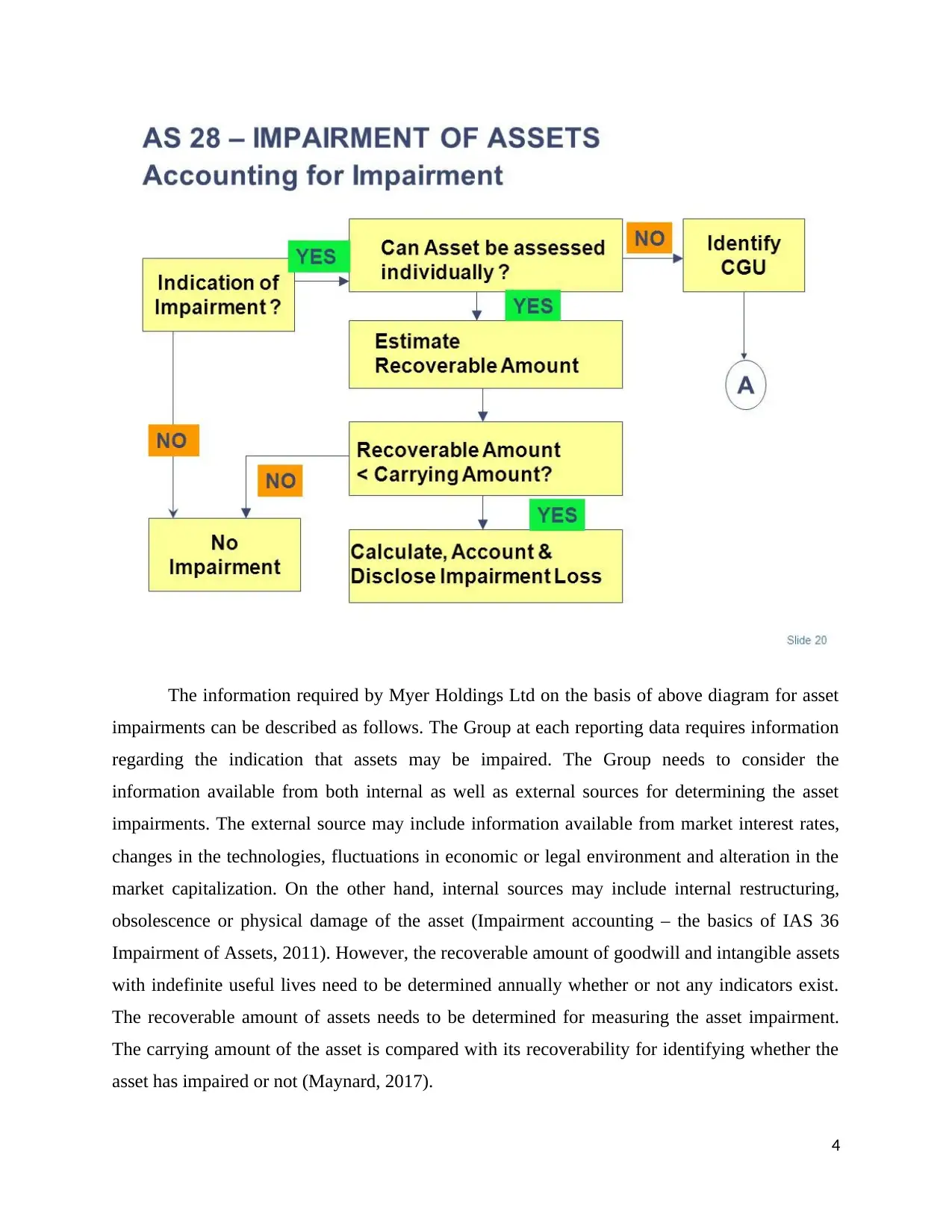
The information required by Myer Holdings Ltd on the basis of above diagram for asset
impairments can be described as follows. The Group at each reporting data requires information
regarding the indication that assets may be impaired. The Group needs to consider the
information available from both internal as well as external sources for determining the asset
impairments. The external source may include information available from market interest rates,
changes in the technologies, fluctuations in economic or legal environment and alteration in the
market capitalization. On the other hand, internal sources may include internal restructuring,
obsolescence or physical damage of the asset (Impairment accounting – the basics of IAS 36
Impairment of Assets, 2011). However, the recoverable amount of goodwill and intangible assets
with indefinite useful lives need to be determined annually whether or not any indicators exist.
The recoverable amount of assets needs to be determined for measuring the asset impairment.
The carrying amount of the asset is compared with its recoverability for identifying whether the
asset has impaired or not (Maynard, 2017).
4
impairments can be described as follows. The Group at each reporting data requires information
regarding the indication that assets may be impaired. The Group needs to consider the
information available from both internal as well as external sources for determining the asset
impairments. The external source may include information available from market interest rates,
changes in the technologies, fluctuations in economic or legal environment and alteration in the
market capitalization. On the other hand, internal sources may include internal restructuring,
obsolescence or physical damage of the asset (Impairment accounting – the basics of IAS 36
Impairment of Assets, 2011). However, the recoverable amount of goodwill and intangible assets
with indefinite useful lives need to be determined annually whether or not any indicators exist.
The recoverable amount of assets needs to be determined for measuring the asset impairment.
The carrying amount of the asset is compared with its recoverability for identifying whether the
asset has impaired or not (Maynard, 2017).
4
Paraphrase This Document
Need a fresh take? Get an instant paraphrase of this document with our AI Paraphraser
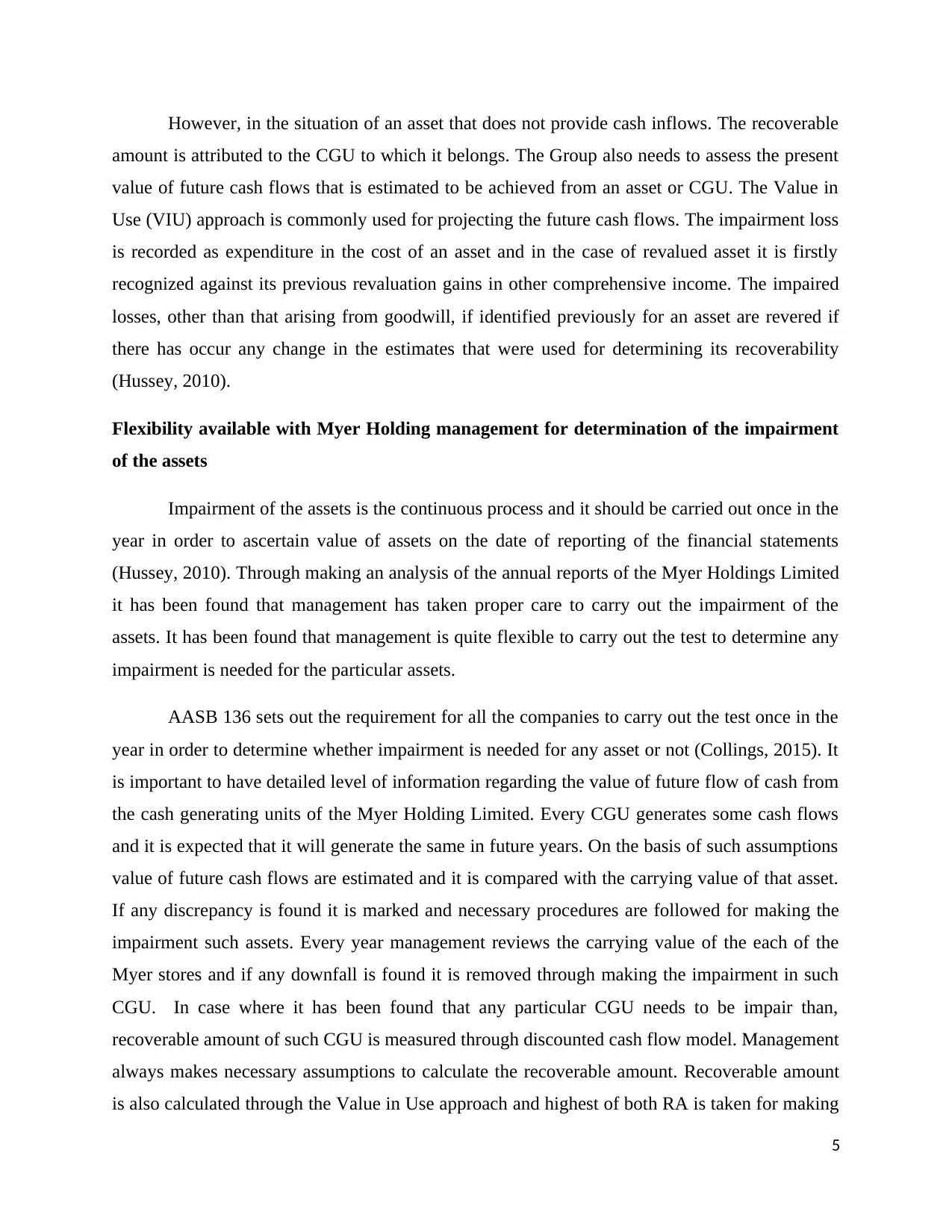
However, in the situation of an asset that does not provide cash inflows. The recoverable
amount is attributed to the CGU to which it belongs. The Group also needs to assess the present
value of future cash flows that is estimated to be achieved from an asset or CGU. The Value in
Use (VIU) approach is commonly used for projecting the future cash flows. The impairment loss
is recorded as expenditure in the cost of an asset and in the case of revalued asset it is firstly
recognized against its previous revaluation gains in other comprehensive income. The impaired
losses, other than that arising from goodwill, if identified previously for an asset are revered if
there has occur any change in the estimates that were used for determining its recoverability
(Hussey, 2010).
Flexibility available with Myer Holding management for determination of the impairment
of the assets
Impairment of the assets is the continuous process and it should be carried out once in the
year in order to ascertain value of assets on the date of reporting of the financial statements
(Hussey, 2010). Through making an analysis of the annual reports of the Myer Holdings Limited
it has been found that management has taken proper care to carry out the impairment of the
assets. It has been found that management is quite flexible to carry out the test to determine any
impairment is needed for the particular assets.
AASB 136 sets out the requirement for all the companies to carry out the test once in the
year in order to determine whether impairment is needed for any asset or not (Collings, 2015). It
is important to have detailed level of information regarding the value of future flow of cash from
the cash generating units of the Myer Holding Limited. Every CGU generates some cash flows
and it is expected that it will generate the same in future years. On the basis of such assumptions
value of future cash flows are estimated and it is compared with the carrying value of that asset.
If any discrepancy is found it is marked and necessary procedures are followed for making the
impairment such assets. Every year management reviews the carrying value of the each of the
Myer stores and if any downfall is found it is removed through making the impairment in such
CGU. In case where it has been found that any particular CGU needs to be impair than,
recoverable amount of such CGU is measured through discounted cash flow model. Management
always makes necessary assumptions to calculate the recoverable amount. Recoverable amount
is also calculated through the Value in Use approach and highest of both RA is taken for making
5
amount is attributed to the CGU to which it belongs. The Group also needs to assess the present
value of future cash flows that is estimated to be achieved from an asset or CGU. The Value in
Use (VIU) approach is commonly used for projecting the future cash flows. The impairment loss
is recorded as expenditure in the cost of an asset and in the case of revalued asset it is firstly
recognized against its previous revaluation gains in other comprehensive income. The impaired
losses, other than that arising from goodwill, if identified previously for an asset are revered if
there has occur any change in the estimates that were used for determining its recoverability
(Hussey, 2010).
Flexibility available with Myer Holding management for determination of the impairment
of the assets
Impairment of the assets is the continuous process and it should be carried out once in the
year in order to ascertain value of assets on the date of reporting of the financial statements
(Hussey, 2010). Through making an analysis of the annual reports of the Myer Holdings Limited
it has been found that management has taken proper care to carry out the impairment of the
assets. It has been found that management is quite flexible to carry out the test to determine any
impairment is needed for the particular assets.
AASB 136 sets out the requirement for all the companies to carry out the test once in the
year in order to determine whether impairment is needed for any asset or not (Collings, 2015). It
is important to have detailed level of information regarding the value of future flow of cash from
the cash generating units of the Myer Holding Limited. Every CGU generates some cash flows
and it is expected that it will generate the same in future years. On the basis of such assumptions
value of future cash flows are estimated and it is compared with the carrying value of that asset.
If any discrepancy is found it is marked and necessary procedures are followed for making the
impairment such assets. Every year management reviews the carrying value of the each of the
Myer stores and if any downfall is found it is removed through making the impairment in such
CGU. In case where it has been found that any particular CGU needs to be impair than,
recoverable amount of such CGU is measured through discounted cash flow model. Management
always makes necessary assumptions to calculate the recoverable amount. Recoverable amount
is also calculated through the Value in Use approach and highest of both RA is taken for making
5
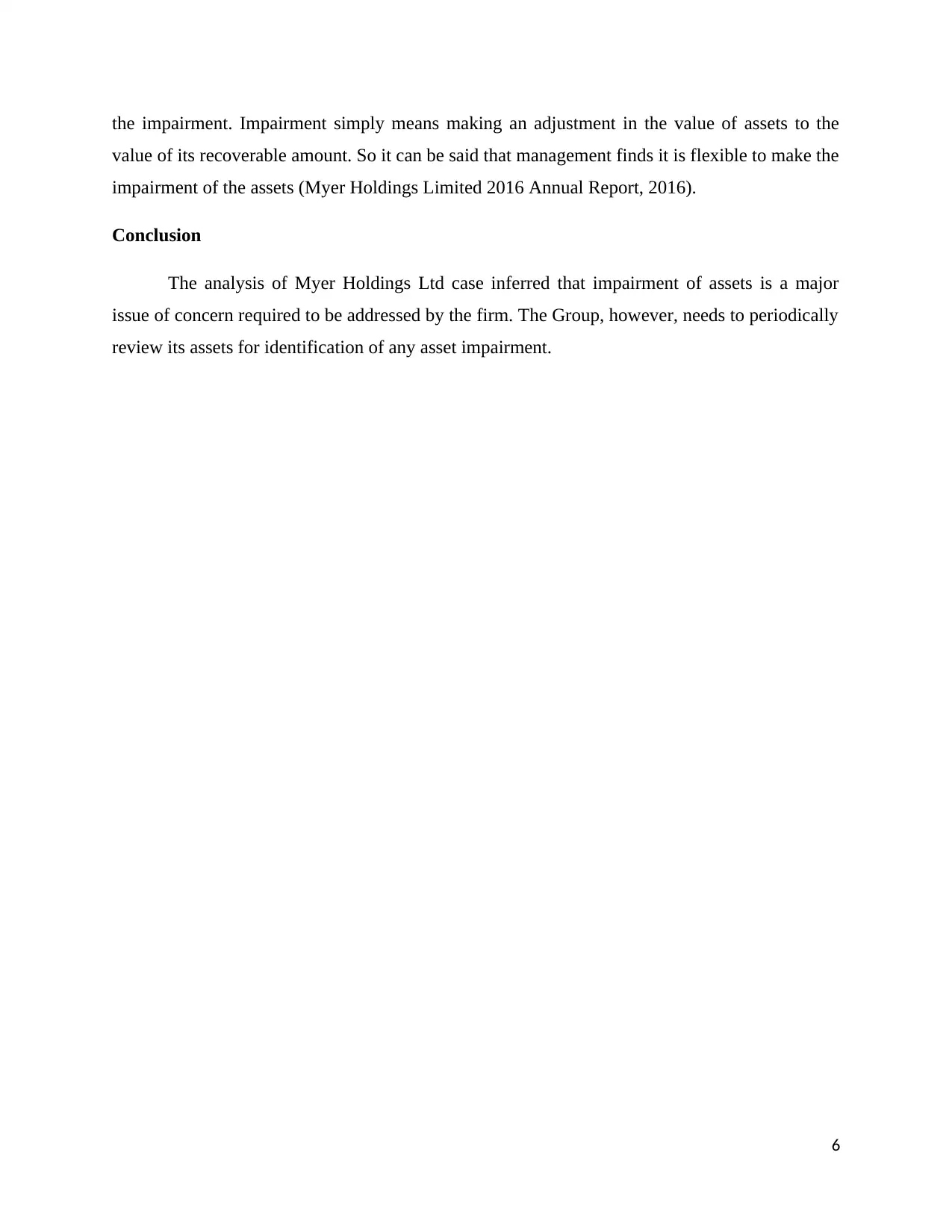
the impairment. Impairment simply means making an adjustment in the value of assets to the
value of its recoverable amount. So it can be said that management finds it is flexible to make the
impairment of the assets (Myer Holdings Limited 2016 Annual Report, 2016).
Conclusion
The analysis of Myer Holdings Ltd case inferred that impairment of assets is a major
issue of concern required to be addressed by the firm. The Group, however, needs to periodically
review its assets for identification of any asset impairment.
6
value of its recoverable amount. So it can be said that management finds it is flexible to make the
impairment of the assets (Myer Holdings Limited 2016 Annual Report, 2016).
Conclusion
The analysis of Myer Holdings Ltd case inferred that impairment of assets is a major
issue of concern required to be addressed by the firm. The Group, however, needs to periodically
review its assets for identification of any asset impairment.
6
⊘ This is a preview!⊘
Do you want full access?
Subscribe today to unlock all pages.

Trusted by 1+ million students worldwide
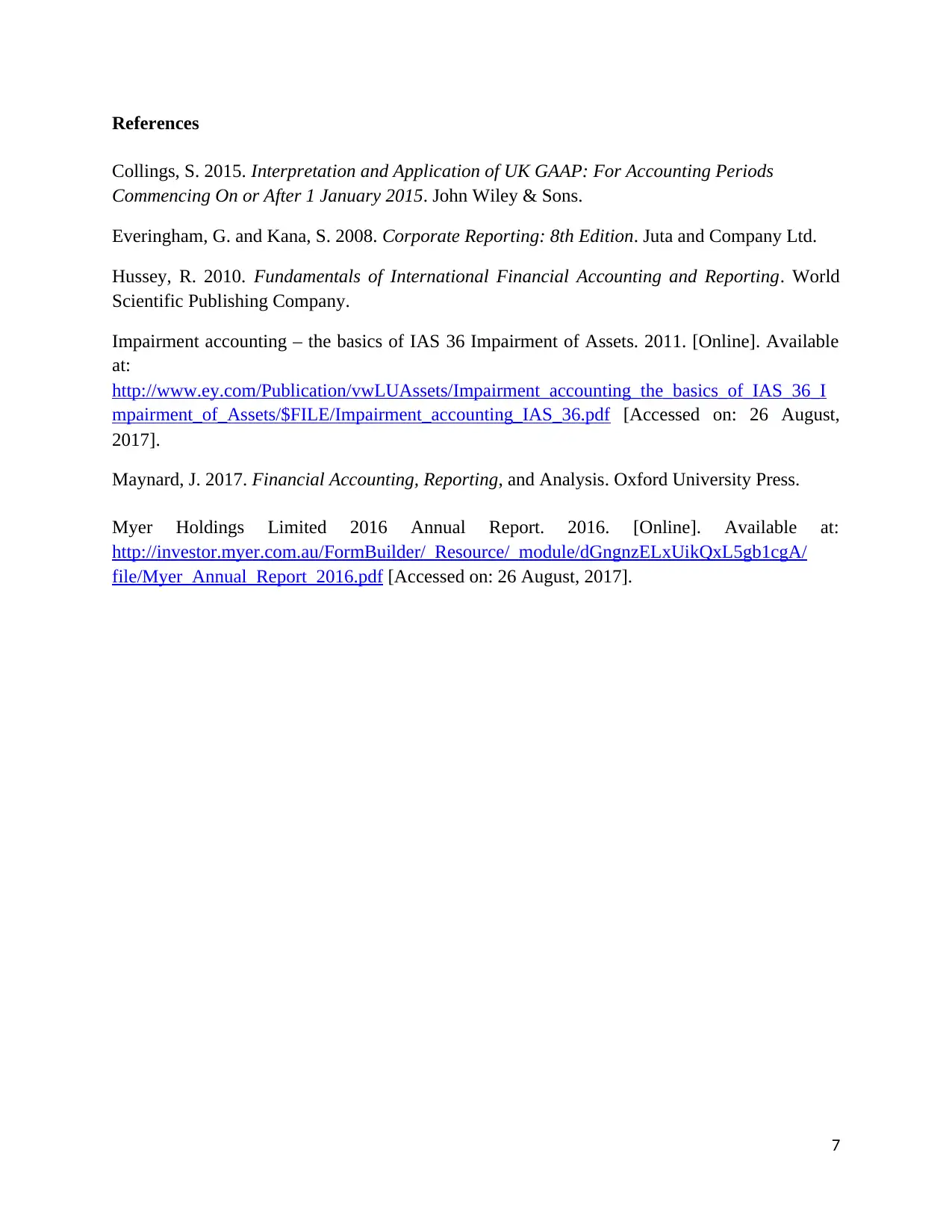
References
Collings, S. 2015. Interpretation and Application of UK GAAP: For Accounting Periods
Commencing On or After 1 January 2015. John Wiley & Sons.
Everingham, G. and Kana, S. 2008. Corporate Reporting: 8th Edition. Juta and Company Ltd.
Hussey, R. 2010. Fundamentals of International Financial Accounting and Reporting. World
Scientific Publishing Company.
Impairment accounting – the basics of IAS 36 Impairment of Assets. 2011. [Online]. Available
at:
http://www.ey.com/Publication/vwLUAssets/Impairment_accounting_the_basics_of_IAS_36_I
mpairment_of_Assets/$FILE/Impairment_accounting_IAS_36.pdf [Accessed on: 26 August,
2017].
Maynard, J. 2017. Financial Accounting, Reporting, and Analysis. Oxford University Press.
Myer Holdings Limited 2016 Annual Report. 2016. [Online]. Available at:
http://investor.myer.com.au/FormBuilder/_Resource/_module/dGngnzELxUikQxL5gb1cgA/
file/Myer_Annual_Report_2016.pdf [Accessed on: 26 August, 2017].
7
Collings, S. 2015. Interpretation and Application of UK GAAP: For Accounting Periods
Commencing On or After 1 January 2015. John Wiley & Sons.
Everingham, G. and Kana, S. 2008. Corporate Reporting: 8th Edition. Juta and Company Ltd.
Hussey, R. 2010. Fundamentals of International Financial Accounting and Reporting. World
Scientific Publishing Company.
Impairment accounting – the basics of IAS 36 Impairment of Assets. 2011. [Online]. Available
at:
http://www.ey.com/Publication/vwLUAssets/Impairment_accounting_the_basics_of_IAS_36_I
mpairment_of_Assets/$FILE/Impairment_accounting_IAS_36.pdf [Accessed on: 26 August,
2017].
Maynard, J. 2017. Financial Accounting, Reporting, and Analysis. Oxford University Press.
Myer Holdings Limited 2016 Annual Report. 2016. [Online]. Available at:
http://investor.myer.com.au/FormBuilder/_Resource/_module/dGngnzELxUikQxL5gb1cgA/
file/Myer_Annual_Report_2016.pdf [Accessed on: 26 August, 2017].
7
1 out of 7
Related Documents
Your All-in-One AI-Powered Toolkit for Academic Success.
+13062052269
info@desklib.com
Available 24*7 on WhatsApp / Email
![[object Object]](/_next/static/media/star-bottom.7253800d.svg)
Unlock your academic potential
Copyright © 2020–2025 A2Z Services. All Rights Reserved. Developed and managed by ZUCOL.





